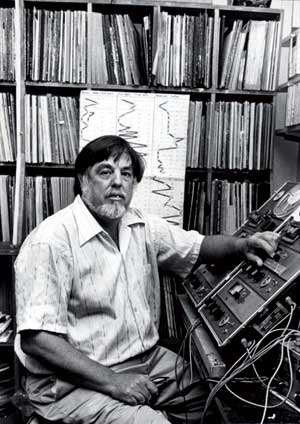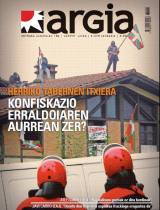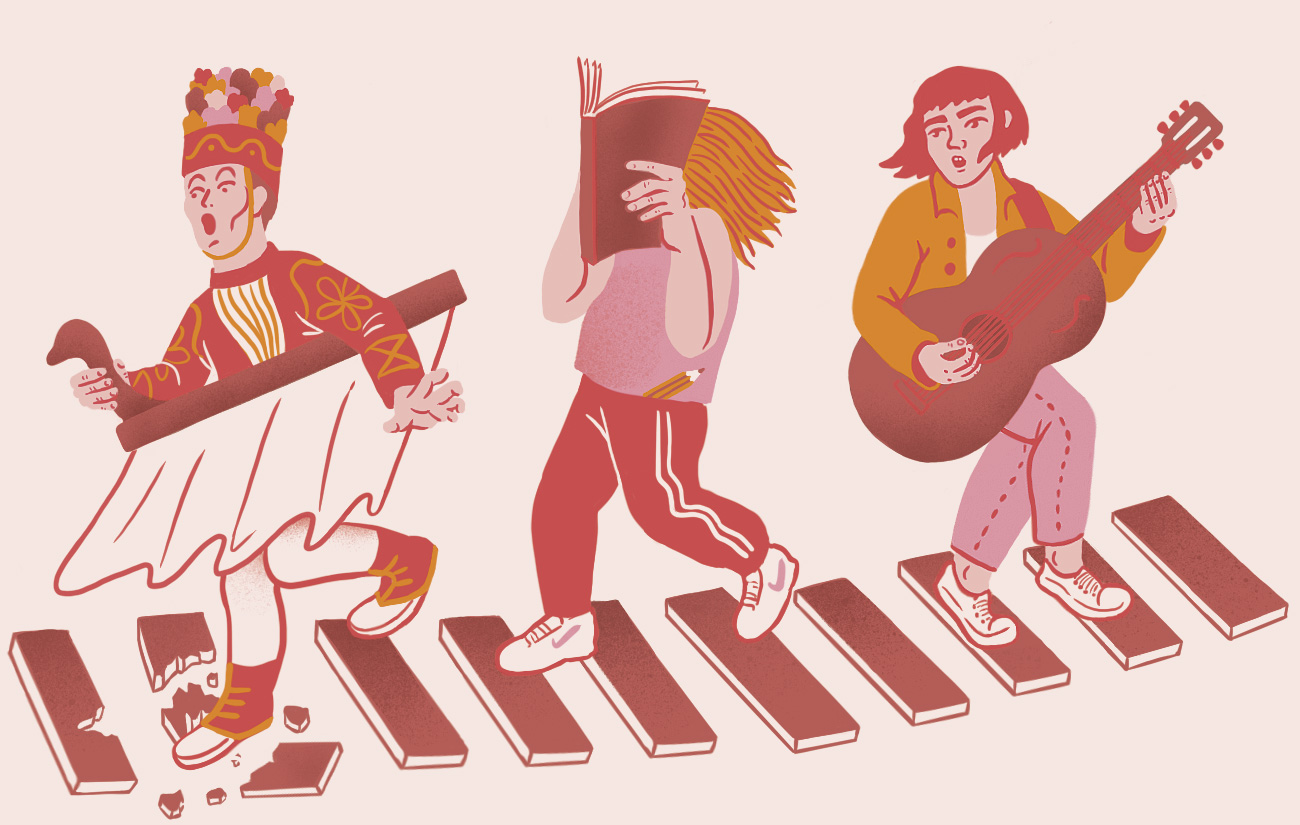The researcher who recorded the Basques singing
- This year marks the 100th anniversary of the birth of Alan Lomax (Texas, EE.Durante all his life gathered folk music, and among thousands of recordings, his files include those made in the Basque Country.

These are two albums, the numbers of a large collection: The Basque Country Biscay and Guipuzcoa, and The Basque Country: Navarre. They are both part of the music collection recorded in Spain, and they are the work of Alan Lomax, a researcher who gave life to the collection of the world's Folk. Born in the United States, in addition to his traditional music, he composed in Europe in the early 50s of the last century, both Italian, British or Spanish. It wasn't hard work. As he left it, “I walked wandering for months and I never found it hard to find the best singers and musicians of the peoples, because everyone knew them.” By then, however, Lomax had already come a tremendous path in this kind of work, one of the greatest folk music collectors of the 20th century.
Without color, Lomax is harder to define, as I walk through the fields that are and are not. He was a folklorist, ethnomusicologist, archivist, writer, professor, political activist, oral historian and filmmaker. He made recordings, concerts and radio shows both in the United States and in the United Kingdom in the 1940s, 50s and 60s, giving a huge push to the folk movement. USA, Franklin Delano Roosevelt, at the time of New Deal started in 1932, alan Lomax recorded thousands of songs on aluminum and acetate discs for the American Folk Song archive at the Library of Congress. He first worked on helping his father, John A. Lomax with folklorist and collector. It was the first time he helped him gather folk songs at the age of seventeen: American Ballads and Folk Songs (1934) and Black Folk Songs as Sung by Lead Belly (1936). From then on, young Alan Lomax will work with other colleagues and collaborators: She was in Florida and Bahamas in 1935 and, in 1937, married student Elizabeth Harold Goodman from the University of Texas and made folk recordings in Haiti, Alabama, Appalachia and Mississippi.
Between 1937 and 1942 he was responsible for the Folk Music Archive of the Library of Congress and, following the purpose of the institution, did everything possible to promote fieldwork. Considered one of the precursors of oral history, Lomax was interviewed by numerous folk and jazz musicians. He was the first one who, as he walked through the street, interviewed the normal road users. In 1941, taking advantage of his job, he sent telegrams to the field workers who traveled ten states of the EE.UU. And I want you to gather your views on the bombing of Pearl Harbor and the subsequent declaration of war. Then, in 1942, he gathered a series of conversations under the name of Dear Mr. President, in order to ask people their opinion. In short, between 1939 and 1942 Alan Lomax was in good shape in music collection, and during the Second World War, while in the army, he conducted numerous radio programs that connected music and war. Of great prestige and prestige, such as The Martins and the Coys, which was broadcast by the BBC in England. The music of Woody Guthrie, Burl IVES, Pete Seeger and many others was the protagonist in the BBC programme, which was never broadcast in the United States.
In 1942, at a time when the Library of Congress was deprived of subsidies, Lomax continued as such and also met in England, Ireland, the Caribbean, Italy and Spain. By then, Alan Lomax already had the most modern recording technology and completed an extraordinary collection, both inside and outside the United States.
Fleeing the witch hunt
Witch hunt in the United States in 1949. The excuse was communism. The following year, in red alive, the Red Channels pamphlet, of which he was an FBI agent, opened a list of artists and journalists from all over the world, in which the names and surnames of those who believed sympathies to communism were extended to the four winds. The names included Leonard Bernstein, Burl Ives, Dorothy Parker, Pete Seeger, Josh White… and, of course, Alan Lomax.
This summer, the Washington Congress dedicated itself to debating McCarran's law. Accordingly, all subversives would be recorded – they would sign, in the slang – and fingerprints would be collected, travel restricted and stopped in the event of an “emergency”. Lomax was certain that they would pass the law and that, if so, his career would sink and he would not be able to move on. By then, already divorced and with the firm Columbia Records as concluded a contract for recording in Europe, he planned to leave the country.
The passport was hastily renewed, suspended the agreed commitments and departed in the Mauretania on 24 September 1950. Fortunately! In October, FBI agents were interested in Lomax's friends and peers in Germany. However, he did not inform them that he had been forced to leave. And later, when an English newspaper took Alan Lomax as a “witch hunt victim,” he said only when he worked on the Columbia project in the UK. From the United Kingdom it extended its work to four European corners...
Europe, the source of inexhaustible sounds
In England, it is located in London in the 1950s, and from there it formed the extensive collection of eighteen copies of the Columbia World Library of Folk and Primitive Music. The occasion he took to travel to Spain, Scotland, Ireland and Italy, we know that he spent seven months in Spain, for example. He recorded about three hundred items along the peninsula, wrote numerous notes and made hundreds of photographs. Among the works that were recorded in Spain, some artists – such as Miles Davis – praised the saeta received in Seville or the turmoil of the Vigo Gaiters, although they gathered music and songs from different countries: In Mallorca, Ibiza and Formentera, Galicia, Extremadura, Aragon, Valencia and, among us, Bizkaia, Gipuzkoa and Navarra with the help of Lomax Jeanette Bell, both with auxiliary field staff.
In the recordings made in the Basque Country, for example, Eduardo Torner, a collaborator of Lomax, and in those of Aragon, Valencia and Galicia, for example, Julio Caro Baroja himself, among others.
Euskal Herria on two essential records
From 1952 to 53 he was in Euskal Herria, and the result is two albums: The Spanish recordings: In the Basque Country series. The first, dedicated to Bizkaia and Gipuzkoa, gathered 38 songs. Seconds, Basque Country: La Naval, 33.
In the case of the interpreters of his album, corresponding to Bizkaia and Gipuzkoa, there are several well-known names: The bertsolaris Ignazio Eizmendi Basarri and Manuel Olaizola Uztapide are the best known, and along with them are the txistularis groups of Zarautz and Donostia. Along with them are names such as Arantza and Andoni Goikoetxea, or Sotero Erauzkin, Simon Badiola, Pedro Anaito or Javier Bello Portu. This volume is composed of recordings made in Zeanuri, Ergoien, Tolosa, Ondarroa and others.
As for the album from Navarra, the recordings were made in Uitzi, Arizkun, Elizondo, Lesaka and Pamplona, and the brothers Pérez Lazarraga, José and María Fagoaga, Mariano Izeta, Maurizio Elizalde, Migel Anjel Leoz and others are the interpreters. It is worth noting the presence of dulzaina and txistu, and the songs of Leoz jota, both in Basque and Spanish.
Both works are also very fresh, as evidenced by the laughter, applause and twists that are heard in them. Both albums were edited in 2004 by Casa Rounder and have leaflets with photos and curious, the result of the work of Juan Mari Beltran and Aintzane Cámara. Both works can also be heard on the Association for Cultural Equity (ACE) website culturalequity.org that Alan Lomax has launched.
Bistan denez, Alan Lomaxen bilketa baino lehen ere izan ziren atzerrian euskal kantuak grabatu zituztenak. 1938an, esaterako, Song of the Basque Children grabatu zuten Ingalaterran. Haurrak ziren interprete, 1937ko maiatzaren 22ko gauean SS Habana itsasontzian Santurtziko portutik irten eta Southamptonera abiatu ziren haietakoak. Hamar urtetsu geroago, 1949an, Song of the Basques grabatu zuten Boise, Idahon (AEB). Musika astea egin zen Idahoko hiriburuan, eta euskaldunak gonbidatu zituzten. Batu ziren bizkaitar artzainak, diskutitu zuten zer kantatu, zelan, eta parte hartu zuten. Diotenez, negar egin zuen jendeak, Euskal Herri zaharreko kantuak entzun zituenean.
Garaitsuan, baina etxean bertan, kantuak biltzeari lotu zitzaion ospe handiko pilotari Ximun Haran. “Gu pilotariak ginen, eta txoko guztietan gure jokoa erakutsi ondoren, gauean herriko tabernan afaltzeko egiten ziguten gonbita gustura onartzen genuen. Azken-burukoa ekarri bezain laster kanturako gogoa nagusitzen zen, eta kantaldi haiek berandu arte luzatzen ziren. Queheille Altzürükükoak Belatsa kantatu zuen gau batean, letrarik gabeko kanta benetan ederra, gabirai baten hegaldia imitatzen duena. Queheilleri entzuten genion bitartean, Mixel Epherrek ahopeka esan zidan: ‘Bera da hori kantatzen dakien bakarra; berarekin batera desagertuko da kanta ere’. Entzundakoak kezkatu egin ninduen, eta, horrela, Frankfurtera joatea erabaki nuen Grundig bat erostera”. Hasteko, Barkoxen, Senperen eta Amotzen, Larrainen eta Santa Grazin burutu zituen grabazioak, eta ondoren, berriz, Bermeon, Azkoitian eta Bilbon. Ehun zinta inguru grabatu zituzten, eta binilozko sei disko luze izan ziren emaitza, Euskal Museoa bildumaren barruan argitaratuak. 2003an, bestalde, Xiberoko kantüak berrargitaratu zuen Elkar etxeak.
Start of the summer. EHZ festival hangover (atx, headache). You want to breathe after a charged course. Flush the head. Reconnect key elements. Take some time with family, see old friends again and rest (a little) in the daily struggle. Really? !...
As a family, walk to the... [+]
The pintxos of many bars in the Old Part of Donostiarra come to serve in a van with permission to access the old part of Donostia. In the other bars, to eat the potato tortilla pintxo they prepare, you have to queue and take the turn when the morning van enters the old town. A... [+]
If you're a musical follower, Rodrigo Cuevas will sound to you. She has been invited in our lands during the Bilbao Big Week, in the recently completed Atlantikaldia in the Enmusikadas and Orereta de Pamplona, and the Pilgrimage has sung and danced the turn to her large fan... [+]
Herri musikari eskaini dio bizitza osoa Juan Mari Beltranek (Donostia, 1947); biltzen, sortzen eta zabaltzen. Haurtzaroan, Etxarri Aranatzen, heldu zien lehenengo musika tresnei eta familiarekin Donostiara mugituta hasi zen han eta hemen txistua astintzen. Dantza taldeetan... [+]
Euskal herri kulturari ekarpen handia egin zion Gurutzi Arregi Azpeitia (Lemoa 1936, Zornotza 2020) etnografoa asteazken goizaldean hil da 84 urterekin. Besteak beste, Euskal Herriko Atlas Etnografikoaren koordinatzaile izan zen. Durangoko kultur mugimenduetan ere... [+]
The French Ministry of Culture will test the Pass Culture device in five departments: It is aimed at 10,000 people aged 18, and has a virtual endowment of 500 euros each, which can use for a year, consume culture and through an application in exhibitions, cinema tickets, books... [+]
Orain hamar urte Euskal Herrian ez zen Halloween ia-ospatzen. Domu Santu eguna bai, Arimen gaua toki gutxi batzuetan ere bai. Baina Halloween filmeetako eta telebistako kontu amerikarra zelakoan lasai egiten genuen lo Domu Santu Egunaren inguruan. 2007ko urrian Bilbon,... [+]
The powerful Smithsonian Foundation has dedicated the Basque Culture to the great folkloric festival in Washington, which this year celebrates its 25th anniversary. The debate has been whether the Basque representation has been too folkloric or just the opposite, whether it has... [+]
Asteazkenean hasi zen AEBetan Smithsonian Folklife jaialdia, Euskal Autonomia Erkidegoa gonbidatu nagusien artean duela. Euskal erakundeek proiektatu duten irudiak eztabaida eragin ostean jakin da 2018an Katalunia izango dela herrialde gonbidatua.
























